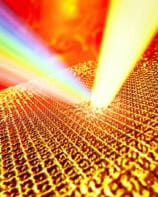
“Heat cloaks” that hide objects from thermal energy and are made from readily available materials such as polystyrene and copper have been unveiled by two independent groups in Singapore. Whether these devices will have practical applications remains unclear, but one possible use for such heat cloaks could be to manage heat in electronic circuits and the batteries used in mobile devices.
Cloaking was first proposed in 2006 by Ulf Leonhardt at the University of St Andrews and by John Pendry of Imperial College London and collaborators at Duke University in North Carolina, all of whom pioneered the field of “transformation optics”. They showed that incident electromagnetic waves could be redirected around an object by metamaterials with tailored refractive indices. As far as an observer is concerned, the object is rendered invisible when surrounded by such a cloak – at least in principle, because practical cloaks are difficult to construct. In 2013 Sebastien Guenneau of the Fresnel Institute in Marseille, France, and colleagues at the Karlsruhe Institute of Technology in Germany applied these ideas to heat by building a 2D cloak based on “transformation thermodynamics”. However, 3D heat cloaks based on this concept are difficult to make because they require highly anisotropic materials of comparable thickness to the object to be cloaked.
Now, researchers in Singapore have sought inspiration from an alternative concept for an electromagnetic cloak that was first proposed by Andrea Alú of the University of Texas at Austin in 2009 and constructed in 2013. An object is wrapped in a thin “mantle” that scatters radiation with the opposite phase of the radiation scattered by the object. This makes it appear as if the object scatters no radiation and is therefore invisible. Such a cloak is necessarily imperfect for light, because the metamaterial can only cancel the scattering from dipolar polarized plane waves. More complex wavefronts such as the radial fronts emanating from a point source have higher-order polarization components including quadrupolar, octupolar and beyond that are not cancelled.
No polarization involved
Both Singapore teams realized that such considerations do not matter for a thermal cloak because heat is a scalar quantity, so a thermal front does not carry polarization. Therefore, a simple bilayer construction can preserve the cloaked object from heat while leaving the thermal propagation in the surroundings perfectly unperturbed.
One group is based at the National University of Singapore and is led by Cheng-Wei Qiu. This team made a cylindrical bilayer cloak using an outer layer of metal with a high thermal conductivity and an inner layer of thermally insulating expanded polystyrene. This was set in a block with a thermal conductivity intermediate between the two. The researchers derived a formula to calculate the thicknesses and conductivities of the various layers for a cloak of any radius. Using this formula, they constructed a cylindrical cloak inside the block. They heated one side to a temperature of 60 °C and cooled the other to 0 °C. Infrared photography showed that, as the heat diffused through the block, an aluminium cylinder placed inside the cloak stayed at a stable temperature; while outside the cloak, the heat flow was unperturbed. The researchers calculated that if the experiment could be made to work for a cylinder, it would also work for a sphere.
The other team is at Nanyang Technical University and is led by Baile Zhang. These researchers built their cloak by encasing a spherical pocket of air in a stainless-steel block by drilling two hemispherical holes in two identical steel blocks and placing them together. The team lined the air pocket with an ultrathin layer of highly conductive copper by placing a copper disc on top of each hemisphere and punching it into the hole with a moulding rod. This cancelled out the distortion to the heat flow from the air pocket and allowed the heat to pass through the block as though the air space were not present. An arbitrary object could be placed inside the air space, effectively replicating the bilayer set-up of the first team with air as the inner insulator. The Nanyang team demonstrated the effectiveness of its cloaking mechanism for a sphere by separating the two hemispheres at various times and measuring the temperature distributions in the steel blocks.
Mobile-phone applications
Both groups are keen to develop practical applications of their cloaks, particularly for heat management in electric circuits. Zhang suggests that such a cloak might be useful in mobile phones. “The battery is very sensitive to temperature and sometimes it can cause [an] explosion,” he says. “It’s very useful to protect such key components from the thermal flux without affecting other components.”
Alú agrees the work could be useful in complex, temperature-sensitive environments, but he believes the more important point of both this work and that of Guenneau is the extension of cloaking to cover diffusion problems. “So far, cloaking has been mostly focused on waves,” he says. “This work proves that cloaking can also be useful in the transient domain for diffusion problems. It would be interesting to see if we can bring it to other types of diffusion problems such as static currents and tomography problems, to see if cloaks may be useful there.”
Both papers are published in Physical Review Letters.



